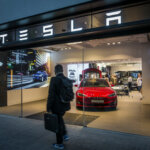Why is EV charging infrastructure so bad?

- Electric vehicle charging is unsatisfactory in the US – providers are stepping up their game.
- UK delays ban on petrol and diesel vehicle sales because charging infrastructure not yet “truly national.”
- Sweden starts constructing on-road electric vehicle charging solution.
Electric vehicle charging might be the latest frontier in the battle against complete climate disaster. As the world burns around us, the use of EVs is one way to mitigate the effects of human consumption on global warming. Electric vehicles are taking up an increasing percentage of the overall auto market share every year — rising from 4% in 2020 to 14% last year.
However, a roadblock to complete uptake of EVs is presenting itself as electric vehicle owners are experience limited charging availability. In America, stations supplied by significant players like ChargePoint, Electrify America, and EVgo are down in numbers. Customers are left without a recharge thanks to unreliable or damaged hardware, and the situation is worsening over time.
This is a common problem for EV drivers that petrol and diesel drivers have never faced. Imagine the number of gas stations was far more limited; of the few available, even fewer are functional. EV chargers more often than not have damaged cables or error codes, or payment and app connectivity are down due to network problems.
Then, when at long last a fully working charging point shows up, EV owners arrive to join a queue of other users.
In the last J.D. Power survey for customer satisfaction on DC fast chargers, EVgo scored below the segment average and slotted in between ChargePoint and Electrify America. Tesla, which operates more than 12,000 stalls in North America, is the only company to score above average.
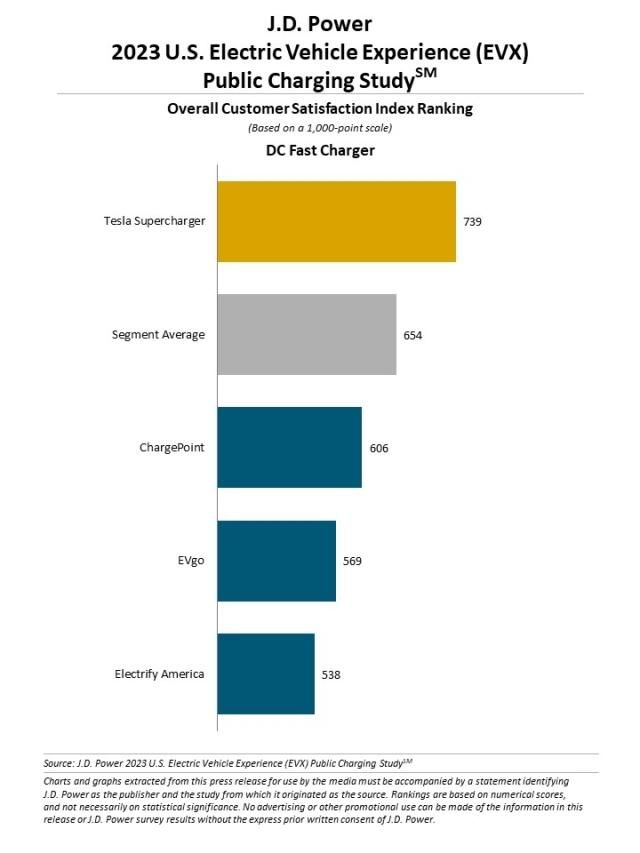
Yesterday, EVgo said it’s made “significant progress” with a renewal campaign aiming to boost reliability at its stations.
In January, EVgo started its “ReNew” program which it says helps the company identify old and faulty chargers for upgrade or repair. In the first two quarters this year, EVgo claims to have “upgraded, replaced, or decommissioned” 120 stalls. That’s about the same amount of chargers it had processed in the first three quarters of 2022.
Apparently, the company has halved station repair times in the last 12 months and its new stations each have at least four stalls, while more are under construction that have six plus.
Currently, EVgo has roughly 1,900 fast chargers on its network.
It’s further trying to improve customer service and, for new EV owners, adding education into the mix. To do so, it’s staffing more members for its 24/7 customer service offering to help with EV questions and providing help with accounts and charging.
EVgo’s got content that includes a talk show-style video series to help teach EV drivers about electric cars and charging, as well as advertise the company’s plug-and-charge AutoCharge-Plus service that enables some EV models to start charging without opening the app.
It also owns PlugShare, an EV route mapping app powered by electric vehicle owners for over a decade. EV owners check in at chargers and report their experiences. That should mean EVgo is fully aware of any issues fast.
Drivers take to Twitter to highlight the issues they encounter – for the benefit of fellow users, and to alert providers.
@evgonetwork session in Rancho Cordova, CA. Goes for 0.1kWh, about 5 seconds, and quits as complete. 🤦🏻♂️ First charge with this car, but can’t isolate the problem because the other dispenser is down @RateYourCharge
EVgo account credit is meaningless if you can’t use it. pic.twitter.com/qx1wjpQFfo— Erik Yde (@erikyde) September 24, 2023
Tesla owners are enjoying the best charging experience thanks to the extensive Tesla network that includes easy charging “handshakes” that are handled by the car and not necessarily started by the app or stall payment screen.
This user’s experience, shared via by @rateyourcharge was most disrupted by a lack of ‘nearby’ food options.
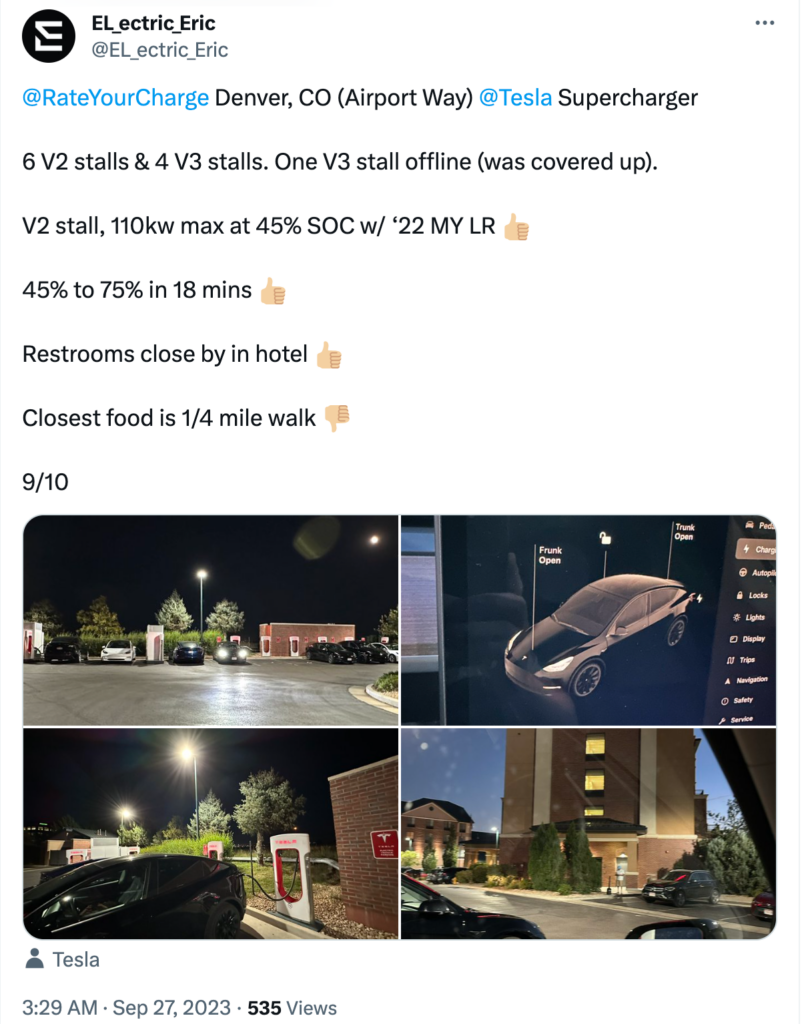
High ratings for this charging point.
Electric vehicle charging: shifting into gear
The charging landscape may evolve over time as Tesla’s once proprietary charging connector, now known as the North American Charging Standard (or NACS), is getting adopted by virtually every car brand: names include Ford, GM, Polestar, Volvo, Mercedes-Benz, Nissan, Honda, Fisker, and Jaguar.
YOU MIGHT LIKE

Inside the walled garden: Tesla will share its chargers
As these brands slowly release their own EV offerings with NACS ports on board, EVgo and other charging companies like ChargePoint might soon have fewer complications to – and fewer excuses for not – building a reliable network.
EVgo even added Tesla connectors at some of its stations, although primarily only supports 50 kW speeds because they are based on CHAdeMO to Tesla adapters. For non-Tesla EVs, EVgo says “nearly all” its locations now include 350 kW chargers.
Other providers are also trying to improve: in August it was announced that ChargePoint would spend millions to boost station reliability to “nearly 100 percent.”
In the early days of EV adoption, buyers would approach a new car with careful charging plans in place: they’d install home chargers, identify locations near work, and map out stations before a road trip.
It might be that as EVs become more common, new owners are less considered; they aren’t planning for charging availability or reliability. However, the accessibility of electric vehicles has to be relative to charging availability.
Is it the case that fewer owners rely on home-charging, so the issues with on-the-go access have got more attention than before? Perhaps people buying EVs have good intentions and assume that the infrastructure is up to standard?
Hyundai is offering free home chargers and installation discounts for new EV buyers. The automaker is offering a free home electric vehicle charger plus up to $600 off installation costs with the purchase or lease of select Hyundai models.
The offer applies to the ChargePoint Home Flex Level 2 charger which is currently available on the Hyundai Home Marketplace where it’s currently listed at $549. The charger supports up to 50 amps.
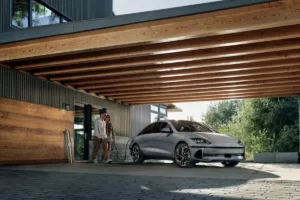
Hyundai’s home charger install deal only works with residential properties. Image: Hyundai.
Of course, there are caveats: the install fee credit applies only to services ordered through Hyundai’s website.
Slowing the change
Over in the UK, Prime Minister Rishi Sunak has delayed a ban on new petrol and diesel vehicles until 2035. The U-turn has been blamed on the cost of living and the need to install charging stations – the shift to electric vehicles isn’t feasible until charging infrastructure is “truly nationwide.”
As with much of the UK’s infrastructure, it’s easy to assume everything’s up to scratch – if you’re visiting London. The capital city has more electric vehicle charging points than three other major cities (Birmingham, Manchester, and Newcastle) combined.
London has an average of 131 electric vehicle chargers for every 100,000 people.
Throughout the rest of the UK, this average is significantly lower at just 41.8 chargers per 100,000 people.
Northern Ireland’s (NI) public charging infrastructure is lagging behind the rest of the United Kingdom, with 23 chargers available per 100,000 people. There are also only three rapid chargers per 100,000 people.
The shortage of infrastructure in NI is being blamed on the cost of grid connection. Because it’s so expensive, it’s hard for operators to set up a viable business model in the area.
Thomas O’Hagan is the Co-founder of Weev, a car charging company, which is investing £20m in the network in NI.

Thomas O’Hagan. Via BBC.
He said the cost of upgrading grid connections to accommodate powerful chargers “could be anywhere between three to 10 times” more expensive than it is in mainland Britain.
“We are having to pay for the full network upgrade, whereas in [the] GB their policy is that the operator only has to pay for the connection and not the upgrade of the network,” he said.
EV charging on the go
Electric road projects are beginning to appear as a potential solution to supplement static charging.
“This is really an approach that can charge vehicles in any type of shape, meaning vehicles that are both buses or vans or passenger cars or trucks — but it can also charge a vehicle while either driving or while standing still,” Stefan Tongur, VP of U.S. business development at Electreon, told CNBC.
Electric roads would prove most useful to public transport and fleet vehicles which often drive the same routes over and over. Wireless charging roads at bus stops could be ideal.
In June this year, Sweden began building the world’s first permanent electrified road for EVs to charge while driving. This came as the EU passed a landmark law to require all new cars sold to have zero CO2 emissions from 2035.
“We think the electrification solution is the way forward for decarbonising the transport sector and we are working with a number of solutions,” Jan Pettersson, Director of Strategic Development at Trafikverket, the Swedish transport administration, told Euronews Next.
Electrified roads can provide charging in one of three ways: a catenary system, conductive system, or inductive system.
Catenary systems look familiar – overhead wires provide electricity but can only be used for heavy-duty vehicles.
Conductive charging works for heavy-duty vehicles and private cars as long as there’s a conduction system such as a rail. Vehicles charge through a stick touching the rail.
Inductive charging systems use special equipment buried under the road that sends electricity to a coil in the EV.
As things stand, much of the Electric Road System focuses on trucks. This is because static charging takes such a long time – their batteries have to be big enough to support long-distance travel (although, better charging infrastructure would mean more frequent charging opportunity and smaller batteries could be feasible).
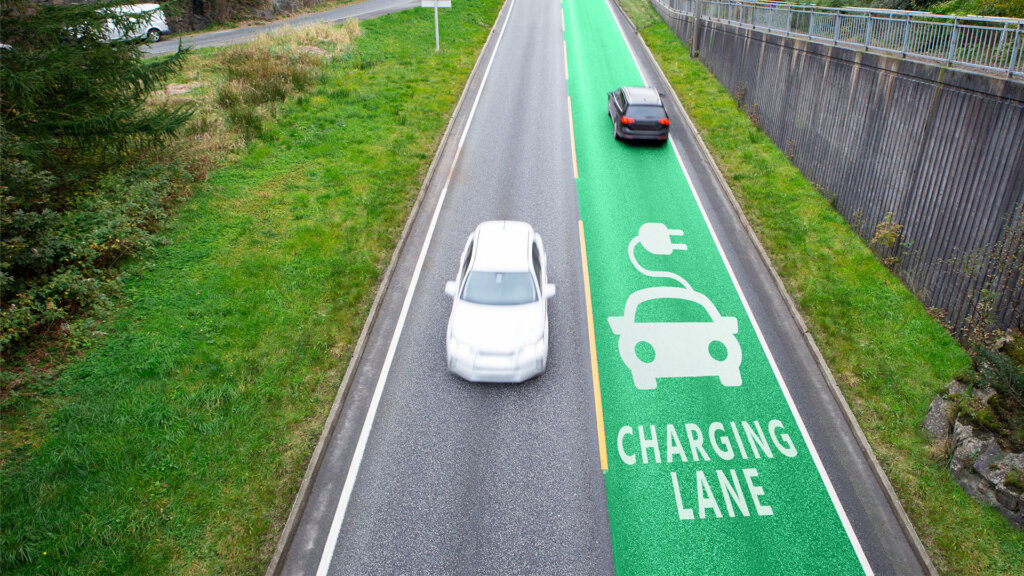
Sweden, as ever, ahead of the curve. Image via Top Gear.
A recent study has shown, however, that private cars stand to benefit from an Electric Road System.
A study simulated the movement patterns of 412 privately driven cars on parts of Swedish national and European roads and found that combining home charging with dynamic charging can reduce the size of the battery by up to 70 per cent.
Researchers also said that not all roads in Sweden would need to be electrified; to do so on only 25 per cent of all roads would be efficient for the system to work.
So, there it is: elecrtic vehicle charging options are currently pretty limited. Even though EVs are increasingly common, the price of doing things in a new way is greater than continuing along the same route… even if it leads to climate catastrophe. Commitments are being made, though, and hopefully improved charging systems – static or otherwise – will cause the EV market to keep growing.






